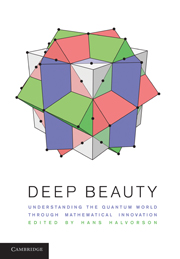Book contents
- Frontmatter
- Contents
- Contributors
- Preface
- Acknowledgments
- Introduction
- I Beyond the Hilbert Space Formalism: Category Theory
- II Beyond the Hilbert Space Formalism: Operator Algebras
- 7 Yet More Ado about Nothing: The Remarkable Relativistic Vacuum State
- 8 Einstein Meets von Neumann: Locality and Operational Independence in Algebraic Quantum Field Theory
- III Behind the Hilbert Space Formalism
- Index
7 - Yet More Ado about Nothing: The Remarkable Relativistic Vacuum State
from II - Beyond the Hilbert Space Formalism: Operator Algebras
Published online by Cambridge University Press: 01 June 2011
- Frontmatter
- Contents
- Contributors
- Preface
- Acknowledgments
- Introduction
- I Beyond the Hilbert Space Formalism: Category Theory
- II Beyond the Hilbert Space Formalism: Operator Algebras
- 7 Yet More Ado about Nothing: The Remarkable Relativistic Vacuum State
- 8 Einstein Meets von Neumann: Locality and Operational Independence in Algebraic Quantum Field Theory
- III Behind the Hilbert Space Formalism
- Index
Summary
Introduction
For millennia, the concept of nothingness, in many forms and guises, has occupied reflective minds, who have adopted an extraordinary range of stances toward the notion—from holding that it is the Godhead itself to rejecting it vehemently as a foul blasphemy. Even among more scientifically inclined thinkers, there has been a similar range of views [49]. We have no intention here to sketch this vast richness of thought about nothingness. Instead, we shall more modestly attempt to explain what mathematical physics has to say about nothingness in its modern scientific guise: the relativistic vacuum state.
What is the vacuum in modern science? Roughly speaking, it is that which is left over after all that can possibly be removed has been removed, where “possibly” refers to neither “technically possible” nor to “logically possible” but rather to “physically possible”—that which is possible in light of (the current understanding of) the laws of physics. The vacuum is therefore an idealization that is only approximately realized in the laboratory and in nature. But it is a most useful idealization and a surprisingly rich concept.
We discuss the vacuum solely in the context of the relativistic quantum theory of systems in four spacetime dimensional Minkowski space, although we briefly indicate how similar states for quantum systems in other spacetimes can be defined and studied. In a relativistic theory of systems in Minkowski space, the vacuum should appear to be the same at every position and in every direction for all inertial observers.
- Type
- Chapter
- Information
- Deep BeautyUnderstanding the Quantum World through Mathematical Innovation, pp. 317 - 342Publisher: Cambridge University PressPrint publication year: 2011
- 4
- Cited by



